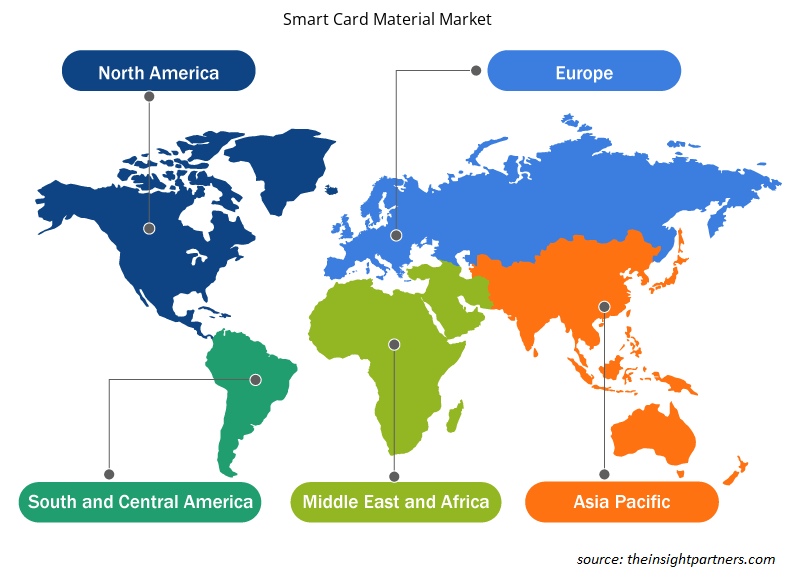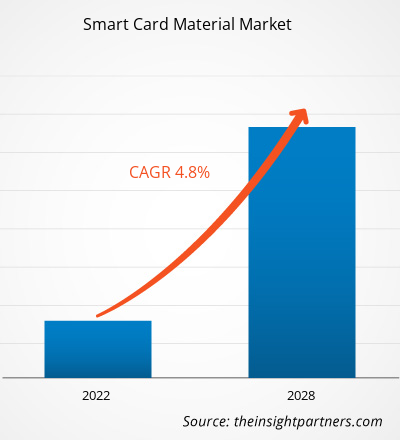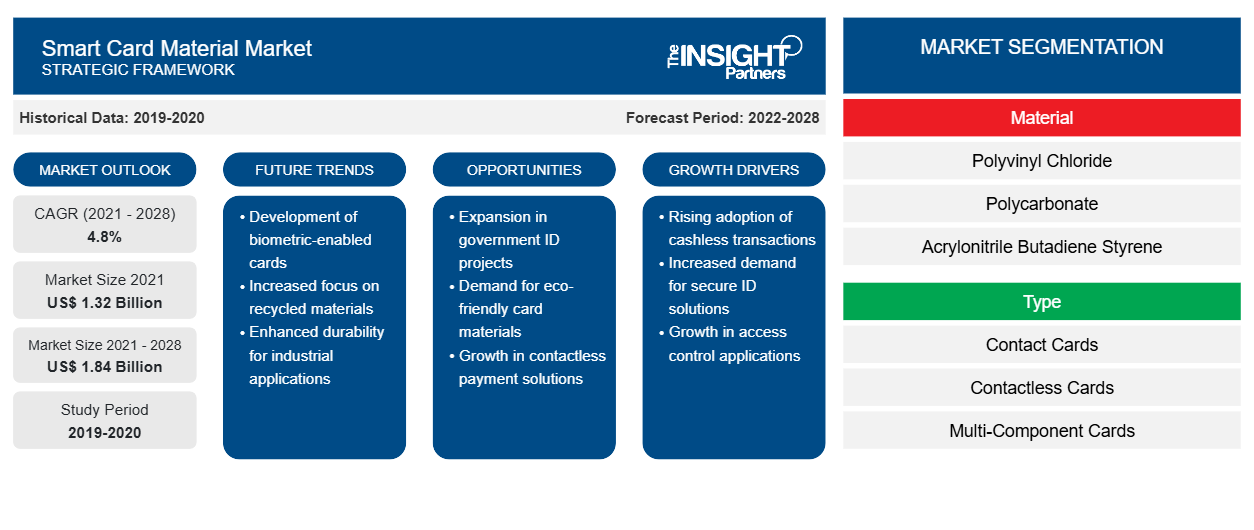Se proyecta que el mercado de materiales para tarjetas inteligentes alcance los 1.837,78 millones de dólares en 2028, frente a los 1.324,57 millones de dólares en 2021; se espera que crezca a una CAGR del 4,8% entre 2021 y 2028.
Una tarjeta inteligente, un tipo de tarjeta con chip, es una tarjeta de plástico que contiene un chip informático integrado, ya sea de tipo memoria o microprocesador, que almacena y procesa datos. Estos datos suelen estar asociados a un valor o a una información, o a ambos, que se almacenan y procesan dentro del chip. Los materiales de las tarjetas inteligentes son los materiales químicos que se utilizan en la fabricación de estas tarjetas. Estos materiales permiten la incrustación e impresión de información sobre ellas.
En 2020, Asia Pacífico tuvo la mayor participación en el mercado mundial de materiales para tarjetas inteligentes . La demanda de materiales para tarjetas inteligentes en esta región está aumentando debido al creciente uso de tarjetas inteligentes en el sector de las telecomunicaciones. Además, la creciente tendencia a la globalización y la proliferación de la industria bancaria, de servicios financieros y de seguros (BFSI) son factores clave que favorecen el crecimiento del mercado de materiales para tarjetas inteligentes en la región.
Personalice este informe según sus necesidades
Obtendrá personalización en cualquier informe, sin cargo, incluidas partes de este informe o análisis a nivel de país, paquete de datos de Excel, así como también grandes ofertas y descuentos para empresas emergentes y universidades.
-
Obtenga las principales tendencias clave del mercado de este informe.Esta muestra GRATUITA incluirá análisis de datos, desde tendencias del mercado hasta estimaciones y pronósticos.
Impacto de la pandemia de COVID-19 en el mercado de materiales para tarjetas inteligentes
La actual pandemia de COVID-19 ha alterado drásticamente el estado del sector químico y de materiales y ha afectado al crecimiento del mercado de materiales para tarjetas inteligentes. La disminución significativa en el desempeño de varios sectores industriales ha afectado la demanda de materiales para tarjetas inteligentes. El impacto de la pandemia varía según los diferentes segmentos de aplicación. Un aumento en el tráfico de datos y los servicios de voz ha beneficiado a muchos actores de las telecomunicaciones, incluidos los operadores de banda ancha y centros de datos móviles. Sin embargo, las medidas de bloqueo impuestas por los gobiernos perturbaron las cadenas de suministro de materias primas como PVS, ABS y PETG necesarias para la fabricación de tarjetas inteligentes. La propagación de la enfermedad ha afectado negativamente a las operaciones en los sectores gubernamental y BFSI. Sin embargo, como las economías planean reactivar sus operaciones, se espera que la demanda de materiales para tarjetas inteligentes aumente a nivel mundial en los próximos años.
Perspectivas del mercado
Crecimiento significativo en los sectores de telecomunicaciones y salud
Las tarjetas inteligentes se utilizan ampliamente en el sector de las telecomunicaciones. El uso más destacado de las tarjetas inteligentes en este sector es en forma de tarjetas de módulo de identidad del suscriptor (SIM) o tarjetas de circuito integrado universal (UICC). Estas tarjetas inteligentes se fabrican principalmente a partir de materiales de cloruro de polivinilo (PVC) y acrilonitrilo butadieno estireno (ABS). La tecnología de tarjetas inteligentes utilizada en aplicaciones en este sector ha experimentado avances continuos en los últimos años, lo que ha impulsado el consumo de estas tarjetas. Además, las organizaciones de atención médica de todo el mundo están implementando tarjetas sanitarias inteligentes con una amplia gama de funciones y aplicaciones.UICC). These smart cards are manufactured mostly from polyvinyl chloride (PVC) and acrylonitrile butadiene styrene (ABS) materials. The smart card technology used in applications in this sector has undergone continuous advancements in the last several years, which has boosted the consumption of these cards. Further, healthcare organizations across the world are implementing smart health cards with a wide range of features and applications.
Perspectivas regionales del mercado de materiales para tarjetas inteligentes
Los analistas de Insight Partners explicaron en detalle las tendencias y los factores regionales que influyen en el mercado de materiales para tarjetas inteligentes durante el período de pronóstico. Esta sección también analiza los segmentos y la geografía del mercado de materiales para tarjetas inteligentes en América del Norte, Europa, Asia Pacífico, Oriente Medio y África, y América del Sur y Central.

- Obtenga datos regionales específicos para el mercado de materiales para tarjetas inteligentes
Alcance del informe sobre el mercado de materiales para tarjetas inteligentes
| Atributo del informe | Detalles |
|---|---|
| Tamaño del mercado en 2021 | 1.320 millones de dólares estadounidenses |
| Tamaño del mercado en 2028 | 1.840 millones de dólares estadounidenses |
| CAGR global (2021-2028) | 4,8% |
| Datos históricos | 2019-2020 |
| Período de pronóstico | 2022-2028 |
| Segmentos cubiertos |
Por material
|
| Regiones y países cubiertos |
América del norte
|
| Líderes del mercado y perfiles de empresas clave |
|
Densidad de actores del mercado de materiales para tarjetas inteligentes: comprensión de su impacto en la dinámica empresarial
El mercado de materiales para tarjetas inteligentes está creciendo rápidamente, impulsado por la creciente demanda de los usuarios finales debido a factores como la evolución de las preferencias de los consumidores, los avances tecnológicos y una mayor conciencia de los beneficios del producto. A medida que aumenta la demanda, las empresas amplían sus ofertas, innovan para satisfacer las necesidades de los consumidores y aprovechan las tendencias emergentes, lo que impulsa aún más el crecimiento del mercado.
La densidad de actores del mercado se refiere a la distribución de las empresas o firmas que operan dentro de un mercado o industria en particular. Indica cuántos competidores (actores del mercado) están presentes en un espacio de mercado determinado en relación con su tamaño o valor total de mercado.
Las principales empresas que operan en el mercado de materiales para tarjetas inteligentes son:
- Compañía química Eastman
- Compañía PetroChina Limitada
- Solvay SA
- KEM UNO
- Sabiduría
Descargo de responsabilidad : Las empresas enumeradas anteriormente no están clasificadas en ningún orden particular.

- Obtenga una descripción general de los principales actores clave del mercado de materiales para tarjetas inteligentes
Información sobre aplicaciones
Según la aplicación, el mercado de material para tarjetas inteligentes se segmenta en BFSI, gobierno, telecomunicaciones, comercio minorista, atención médica, hotelería y otros. El segmento de telecomunicaciones tuvo la mayor participación del mercado de material para tarjetas inteligentes en 2020. Las tarjetas inteligentes se utilizan como tarjetas telefónicas prepago (tarjetas de memoria de valor almacenado) y tarjetas SIM basadas en tarjetas inteligentes con microprocesador o UICC en teléfonos móviles. Los productos de tarjetas inteligentes más vendidos en este sector son SIM y UICC, en términos de volumen y valor.
Algunos de los actores que operan en el mercado global de materiales para tarjetas inteligentes incluyen Eastman Chemical Company, PetroChina Company Limited, Solvay SA, KEM ONE, SABIC, 3A Composites GmbH, Teijin Limited, LG Chem, BASF SE y Westlake Chemical Corporation.
Informe Destacado
- Tendencias progresivas de la industria en el mercado de materiales para tarjetas inteligentes que ayudarán a los actores a desarrollar estrategias efectivas a largo plazo
- Estrategias de crecimiento empresarial adoptadas por empresas que operan en mercados desarrollados y en desarrollo
- Análisis cuantitativo del mercado de materiales para tarjetas inteligentes de 2019 a 2028
- Estimación de la demanda mundial de materiales para tarjetas inteligentes
- Análisis de las cinco fuerzas de Porter para ilustrar la eficacia de los compradores y proveedores que operan en la industria
- Avances recientes para comprender el escenario competitivo del mercado
- Tendencias y perspectivas del mercado, así como factores que impulsan y restringen el crecimiento del mercado de materiales para tarjetas inteligentes
- Asistencia en el proceso de toma de decisiones destacando las estrategias de mercado que sustentan el interés comercial y que conducen al crecimiento del mercado de materiales para tarjetas inteligentes.
- El tamaño del mercado de materiales para tarjetas inteligentes en varios nodos
- Descripción detallada y segmentación del mercado, así como la dinámica de la industria de materiales para tarjetas inteligentes
- Tamaño del mercado de materiales para tarjetas inteligentes en diversas regiones con oportunidades de crecimiento prometedoras
Mercado de materiales para tarjetas inteligentes
Por material
- Cloruro de polivinilo (PVC)
- Policarbonato (PC)
- Acrilonitrilo butadieno estireno (ABS)
- Tereftalato de polietileno-glicol (PETG)
- Otros
Por tipo
- Tarjetas de contacto
- Tarjetas sin contacto
- Tarjetas multicomponentes
Por aplicación
- BFSI
- Gobierno
- Telecomunicación
- Minorista
- Cuidado de la salud
- Hospitalidad
- Otros
Perfiles de empresas
- Compañía química Eastman
- Compañía PetroChina Limitada
- Solvay SA
- KEM UNO
- Sabiduría
- 3A Composites GmbH
- Teijin limitada
- LG Química
- BASF SE
- Corporación química Westlake
- Análisis histórico (2 años), año base, pronóstico (7 años) con CAGR
- Análisis PEST y FODA
- Tamaño del mercado, valor/volumen: global, regional y nacional
- Industria y panorama competitivo
- Conjunto de datos de Excel
Informes recientes
Testimonios
Razón para comprar
- Toma de decisiones informada
- Comprensión de la dinámica del mercado
- Análisis competitivo
- Información sobre clientes
- Pronósticos del mercado
- Mitigación de riesgos
- Planificación estratégica
- Justificación de la inversión
- Identificación de mercados emergentes
- Mejora de las estrategias de marketing
- Impulso de la eficiencia operativa
- Alineación con las tendencias regulatorias























 Obtenga una muestra gratuita para - Mercado de materiales para tarjetas inteligentes
Obtenga una muestra gratuita para - Mercado de materiales para tarjetas inteligentes